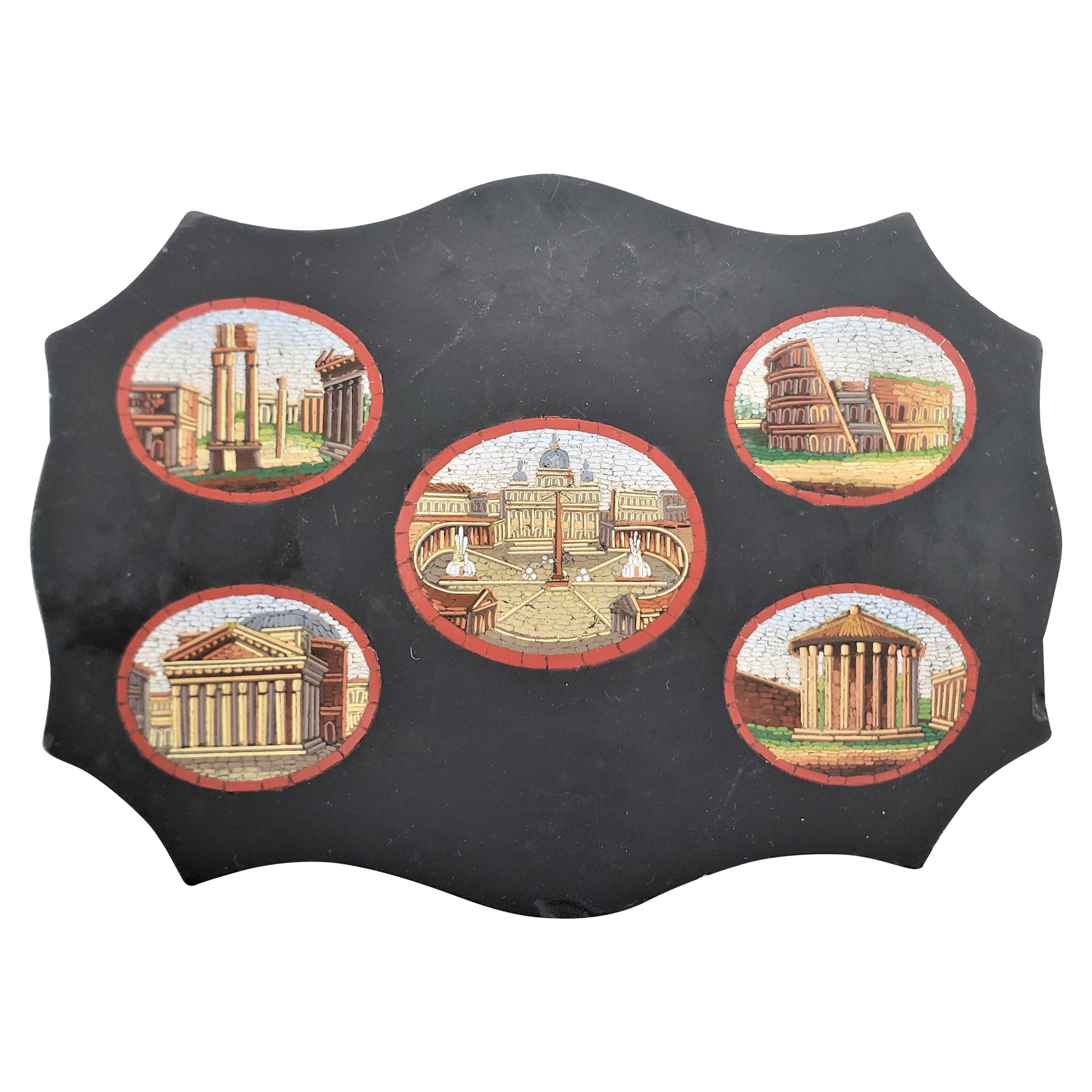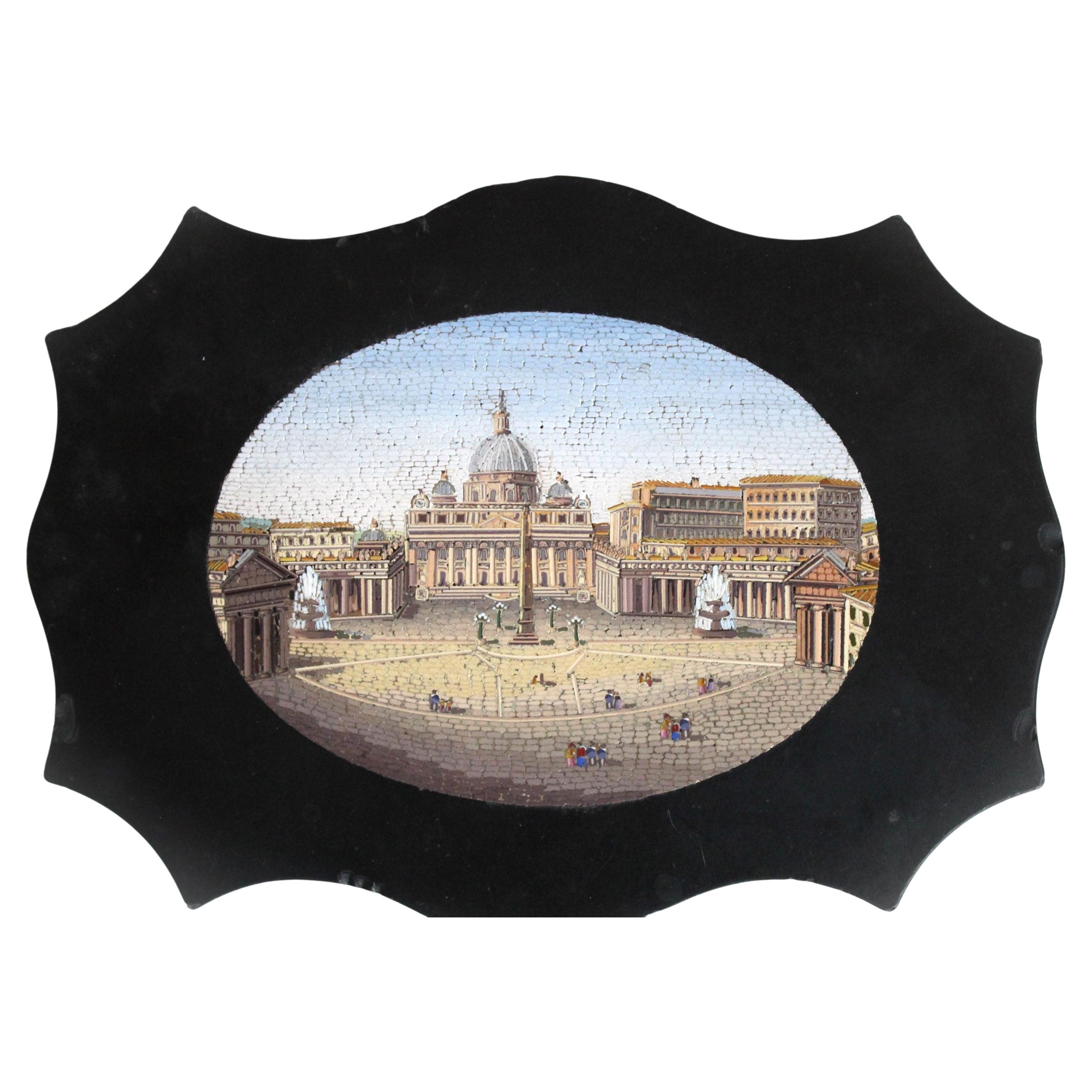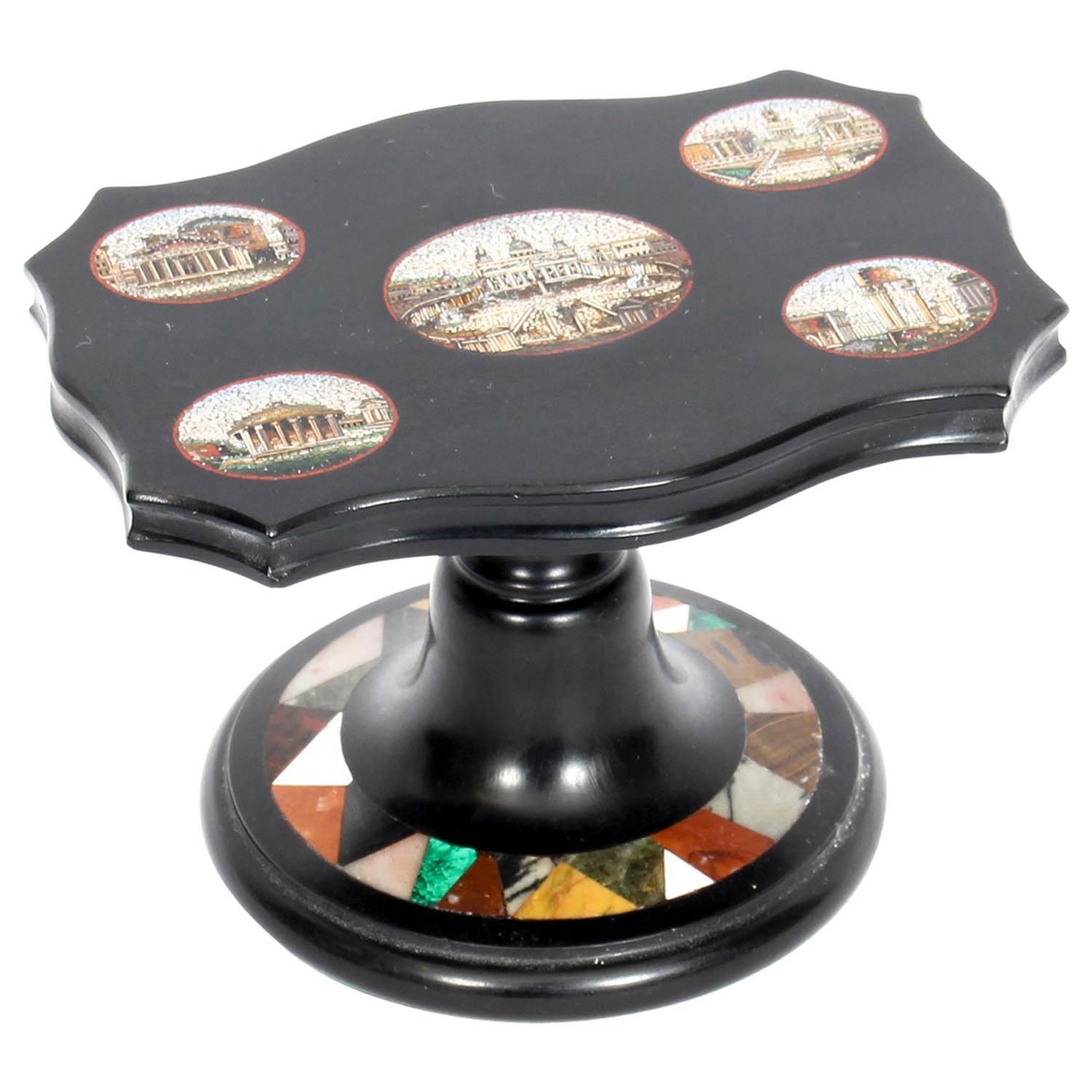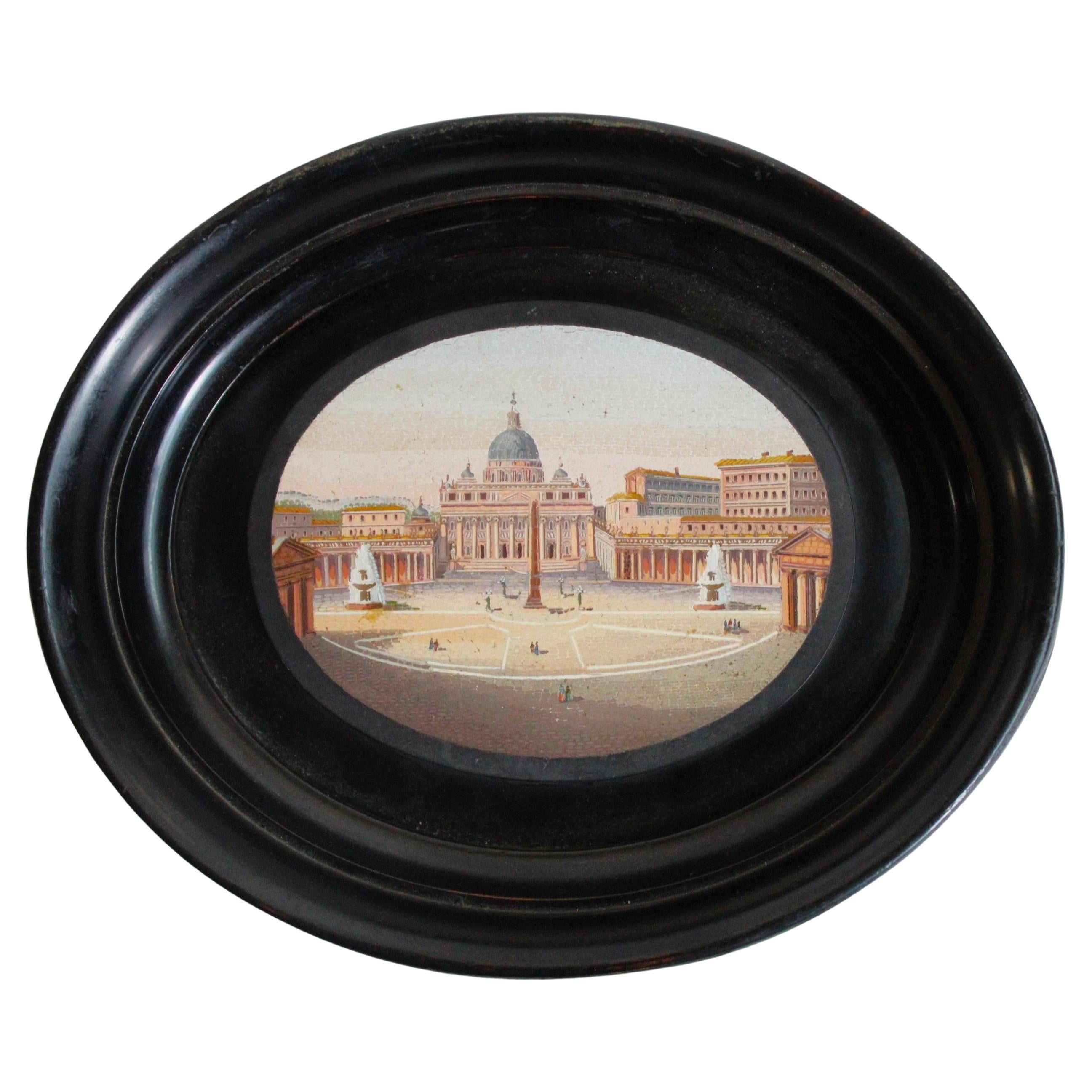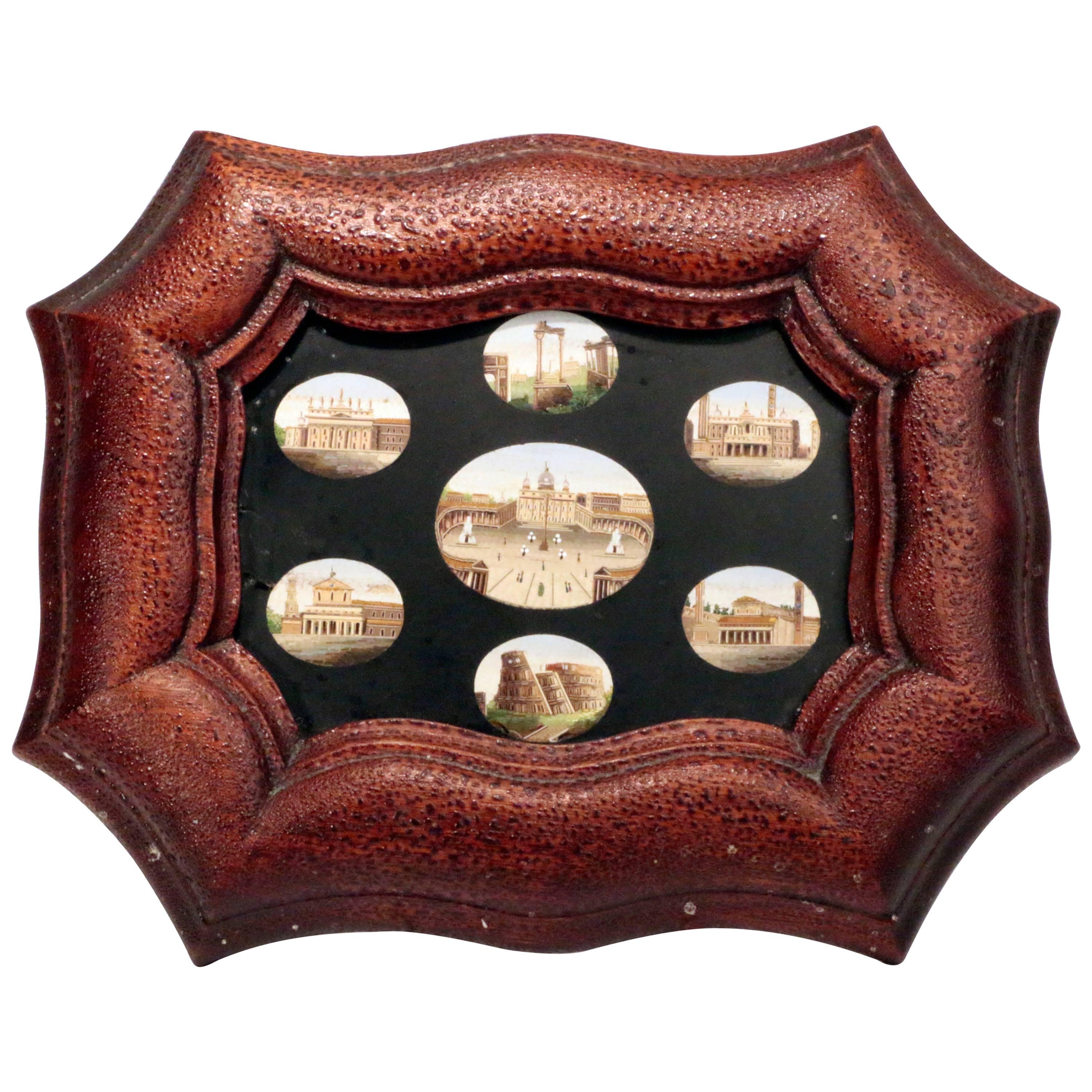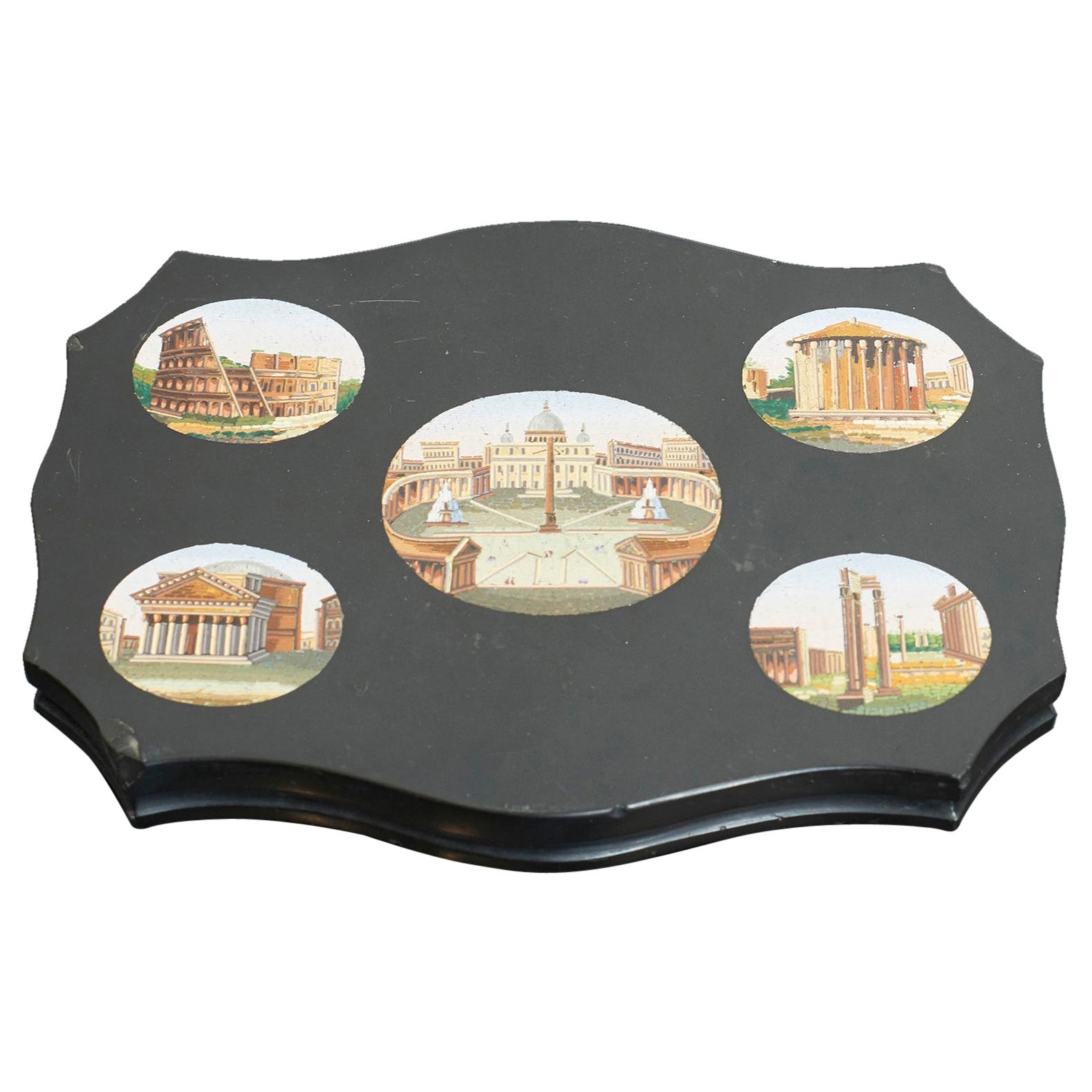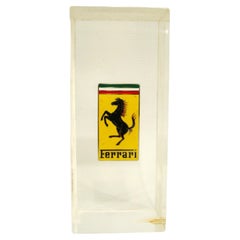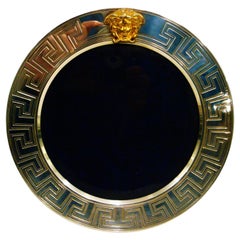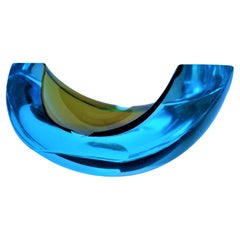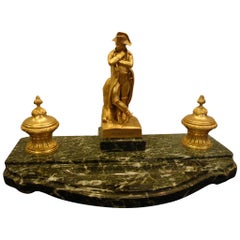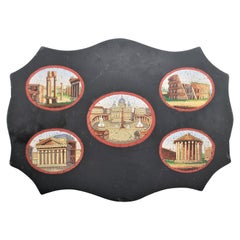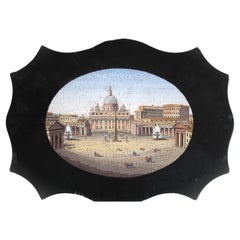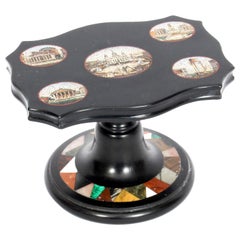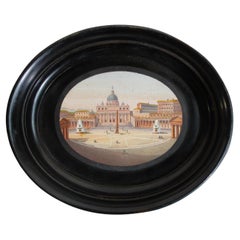Articles similaires à Presse-papiers Grand Tour en micro-mosaïque, Square St. Peter's Square Rome - Vatican
Vous voulez plus d'images ou de vidéos ?
Demander au vendeur plus d'images ou de vidéos
1 sur 12
Presse-papiers Grand Tour en micro-mosaïque, Square St. Peter's Square Rome - Vatican
2 605,79 €
Expédition
Recherche du devis...La promesse 1stDibs :
Garantie d'authenticité,
Garantie de remboursement,
Annulation sous 24 heures
À propos de cet article
"Micro Mosaic, St. Peter's Basilica in Rome, XIXth Century"
19th century oval Micro-mosaic depicting a panoramic view of the basilica and St. Peter's Square in Rome (Vatican), enclosed in a shaped slate with inset oval plaque.
Original Italian Micro Mosaic Grand Tour desk paperweight plaque.
We have specialized in the sale of Art Deco and Art Nouveau and Vintage styles since 1995. If you have any questions we are at your disposal. Pushing the button that reads 'View All From Seller'. And you can see more objects to the style for sale. Why are there so many antiques in Argentina?
In the 1880 – 1940 there was a grate wave of immigration encouraged by the periods of war that were taking place. 1st World War took place between 1914 and 1918 2nd World War took place between 1939 and 1945 The immigrants options were New York or Buenos Aires. Tickets were cheap and in Buenos Aires they were welcomed with open arms, as it was a country where everything was still to be done. Argentina was the country of new opportunities, labour was needed and religious freedom was assured, in many cases the of the family travel first until they were settled and then the rest of the family members join them. In the immigrant museum “Ellis Island Immigrant Building” in New York you can se the promotional posters of the boats that would take them to a new life. Between the years 1895 and 1896, Argentina had the highest DGP (gross domestic product) per capita in the world according to the Maddison Historical Statistics index, this situation arose due to the large amount of food being exported to European countries, which were at war. The Argentinean ships left the port of Buenos Aires with food, but they returned with furniture, clothes and construction elements, (it´s common to see this the old buildings of the historic neighbourhood of San Telmo, the beams with the inscription “Made in England)”, as well as many markets that were built in Buenos Aires, such us the San Telmo Market, whose structure was brought by ship and afterwards assembled in 900 Defensa Street. With the great influence of European immigrants living in the country, the children of the upper classes travelled to study in France, resulting in the inauguration of “La Maison Argentinienne”, on 27th of June 1928, in the international city of Paris, which hosted many Argentinians that were studying in Frace. It´s the fourth house to be built after France, Canada and Belgium, being the first Spanish-speaking one. Still in place today (17 Bd Jourdan, 75014, Paris, France). Many of the children of these wealthy families who attended international art exhibitions, museums and art courses abroad, took a keen interest in the European style. This is why Buenos Aires was at the time referred as “The Paris of South America”. Between the years 1890 and 1920 more than a hundred Palaces were built on Alvear Avenue the most exclusive avenue in Buenos Aires. Today some of these palaces have been transformed into museums, hotels and embassies. In the year 1936, the Kavanagh building was inaugurated, it was the tallest reinforced concrete building in South America. During 1994 the American Society of Civil Engineers distinguished it as an “international engineering milestone”, and it´s now considered a World Heritage of Modern Architecture. At the time was common to hire foreign architects such as Le Corbusier, who visited Buenos Aires/Argentina in 1929 and in 1948 he drew up the blueprints for a house built in La Plata City (which was declared a World Heritage Site). In 1947, the Hungarian architect Marcelo Breuer designed “Parador Ariston” in the seaside city of Mar del Plata. After an Argentinean student at Harvard University convinced him to come to Argentina. He worked on an urban development project in the Casa Amarilla, area of La Boca. The Ukrainian architect, Vladimiro Acosta, arrives in Argentina in 1928 and worked as an architect until que moved to Brazil. Antonio Bonet, a Spanish architect who worked with Le Corbusier in Paris, arrives in Argentina in 1937, where he carried out several architectural works and in 1938 designs the well-known BFK chair. Andres Kálnay, of Hungarian origin, made around 120 architectural masterpieces, among which the former Munich brewery stands out, he even made the furniture’s design. The German architect, Walter Gropius, director of the Bauhaus, lived in Argentina, where he wrote articles for “Sur” magazine and founded in Buenos Aires, an architectural firm with Franz Möller, who was also an architect, where he built two houses. At the same time several famous designers decided to immigrate to Argentina, among them we can find the well-known French designer, Jean-Michel Frank, who arrived in the country in 1940 and also worked for the Rockefeller family. Special pieces were made, which were sold exclusively in the country, such as the well-known German company “WMF”, who sold their products by catalogue, which were chosen by the ladies of high society in the list of wedding gifts, as well as the pieces designed by Christofle. The Swiss sculptor Alberto Giacometti, made special pieces for Argentinean mansions. In 1904 the first Jansen branch outside Paris was established in Buenos Aires, as the Argentinean clientele demanded a large amount of furniture, from the end of the 19th century to the mid-20th century. In 1970, the brand Rigolleau Argentina made pieces authorised by Lalique. The brands Maple and Thompson also set up shop in the country. The French plastic artist, Marcel Duchamp moved to Argentina in 1918-1919. Glass signed Gallé, Charder, Leverre, Schneider, Muller and other French firms. They were bought in flower shops and were given to ladies with beautiful floral arrangements. Some furniture manufacturers travelled to international fairs and bough the patterns to produce the furniture in Argentina, such as the furniture firm Englander and Bonta, who bought the patterns in Italy. It is worth mentioning that in Argentina we have the largest community of Italians outside of Italy, as it is estimated that 70 percent of the inhabitants have at least one Italian descendant, followed by Spanish immigrants. The most Important furniture stores in Argentina: Comte is founded in 1934 (under the direct management of Jean Michel Frank in 1940). Nordiska (Swedish company established in 1934). Churba in 1960, a company that brought foreign designers to present their furniture in the country: Denmark: (Arne Jacobsen, Finn Juhl, Bender Madsen, Ejner Larsen, Poul Kjaerholm, Hans Wegner) Sweden: (Hans Agne Jakobsson, Gustavsberg) United States: (Herman Miller) Finland: (Lisa Johansson, Folke Arstrom, Tapio Wirkkala, Alvar Aalto, Timo Sarpaneva) Swedish Factory: (Orrefors) Italy: (Littala, Vico Magistretti, Emma Gismondi, Gae Aulenti, Angelo Mangiarotti, Elio Martinelli, Gianna Celada, Angelo Mangiarotti, Mario Bellini, Carlo Scarpa) Finland: (Olivia Toikka) Plata Lappas (Lappas Silver): a goldsmith shop founded in 1887 in Argentina by Alcibiades Lappas of Greek origin. In 2019, in Argentina took place “the Art Deco world congress” . Argentina currently has more than 100 Art Deco buildings and another 90 Art Nouveau buildings throughout the city of Buenos Aires. Argentina is a country that has not been involved in many wars, which is why it has been a refuge for works of art and antiques from different periods of time, unlike European countries. That is way many collectors, museums and antique dealers from all over the world visit it, you should not miss the opportunity to visit this great country.
- Dimensions:Hauteur : 17 cm (6,7 po)Largeur : 25,5 cm (10,04 po)Profondeur : 1,8 cm (0,71 po)
- Style:Grand Tour (De la période)
- Matériaux et techniques:Marbre,Mosaïque
- Lieu d'origine:
- Période:
- Date de fabrication:1870
- État:Usure conforme à l'âge et à l'utilisation.
- Adresse du vendeur:Buenos Aires, AR
- Numéro de référence:1stDibs : LU2027344889902
À propos du vendeur
4,9
Vendeur professionnel agréé
Chaque vendeur répond à des normes strictes en matière d'authenticité et de fiabilité
Établi en 2002
Vendeur 1stDibs depuis 2016
320 ventes sur 1stDibs
Temps de réponse habituel : 1 heure
- ExpéditionRecherche du devis...Expédition depuis : Buenos Aires, Argentine
- Politique des retours
Certaines parties de cette page ont été traduites automatiquement. 1stDibs ne garantit pas l'exactitude des traductions. L'anglais est la langue par défaut de ce site web.
Garantie d'authenticité
Bien qu'il soit peu probable que la situation se présente, dans le cas où vous rencontreriez un problème d'authenticité d'un article, contactez-nous dans un délai d'un an pour obtenir un remboursement intégral. DétailsGarantie de remboursement
Si votre article n'est pas conforme à la description, est endommagé pendant le transport ou ne vous est pas livré, contactez-nous sous 7 jours pour obtenir un remboursement intégral. DétailsAnnulation sous 24 heures
Vous disposez d'un délai de 24 heures pour annuler votre achat sans motif.Des vendeurs professionnels agréés
Nos vendeurs de renommée mondiale doivent respecter des normes strictes en matière de service et de qualité, afin de préserver l'intégrité de nos fiches produit.Garantie d'alignement des prix
Si vous constatez qu'un autre vendeur a mis en vente le même article à un prix inférieur sur un autre site, nous nous alignerons sur ce prix.Livraison en toute confiance à l'international
Notre réseau de transporteurs de premier ordre propose des options d'expédition spécialisées dans le monde entier, y compris des livraisons personnalisées.Plus d'articles de ce vendeur
Tout afficherVintage Ferrari Cars Badge / Emblem Lucite Desk Paperweight. Italie années 1970
Vintage Ferrari Badge / Emblem Lucite Desk Paperweight. Italie, années 1970.
Très beau presse-papier publicitaire Ferrari.
Nous sommes spécialisés dans la vente de produits Art Déc...
Catégorie
Fin du 20e siècle, italien, Mid-Century Modern, Presse-papiers
Matériaux
Lucite
Gianni Versace Argent Rond Cadre Photo / Photo / Image 1990's
Par Gianni Versace
Grand cadre rond en argent sterling pour photos de Gianni Versace, avec bordure gravée en forme de clé grecque et masque de la Méduse de Versace en métal doré sur le dessus, tissu bl...
Catégorie
années 1990, italien, Néo-grec, Cadres
Matériaux
Argent sterling
1 876 € Prix de vente
20 % de remise
Large Cenedese Italian Sommerso Murano Glass Ashtray, Italy 1960´s
Par Cenedese
Grand cendrier en verre italien Cenedese Sommerso Murano. Italie années 60
Utilisant la technique Sommerso, cette grande et lourde pièce de verre présente un design inhabituel.
Il re...
Catégorie
Milieu du XXe siècle, italien, Mid-Century Modern, Accessoires pour fumeurs
Matériaux
Verre de Murano
Encrier de bureau Napoléon en bronze, signé Emile Pinedo
Par Émile Pinedo
Encrier de bureau Napoléon Bonaparte en bronze, signé Pinedo avec marque de fonderie. Monté sur un marbre vert des Alpes.
Encrier Napoléon ancie...
Catégorie
Antiquités, années 1890, Français, Empire, Encriers
Matériaux
Bronze
Barovier&Toso Italian Vintage Art Glass Rostrato Murano Vase / Bowl, circa 1938
Par Ercole Barovier, Ferro Toso Barovier
Barovier&Toso vase / bol en verre d'art italien Rostrato Murano, circa 1938
Exquis centre de table du milieu du XXe siècle de Barovier&Toso en verre soufflé de Murano avec un style ...
Catégorie
Milieu du XXe siècle, italien, Mid-Century Modern, Verre
Matériaux
Verre de Murano
1 529 € Prix de vente
20 % de remise
Cadre pour photographies Art Nouveau - Art & Craft en argent sterling émaillé, Cymric 1903
Par Liberty & Co., Archibald Knox, William Hair Haseler
Art Nouveau - Cadre photographique en argent sterling émaillé - William Hutton & Sons 1903.
Cadre photo carré en argent et émail de William Hutton & Sons, dont le dessin est attribué...
Catégorie
Début du 20ème siècle, Britannique, Arts and Crafts, Argent sterling
Matériaux
Argent sterling, Émail
1 946 € Prix de vente
20 % de remise
Suggestions
Antique presse-papier Grand Tour en micro-mosaïque avec Vignettes du Vatican
Ce presse-papier antique en micro-mosaïque Grant Tour n'est pas signé, mais on suppose qu'il provient d'Italie, ou peut-être de la Cité du Vatican, et qu'il date d'environ 1880. Il e...
Catégorie
Antiquités, Fin du XIXe siècle, italien, Victorien, Presse-papiers
Matériaux
Ardoise
Presse-papiers en micro-mosaïque St. Peter's Square
Presse-papiers en micro-mosaïque représentant la place Saint-Pierre. DES PHOTOS SUPPLÉMENTAIRES, DES INFORMATIONS SUR LE LOT ET DES INFORMATIONS SUR L'EXPÉDITION PEUVENT ÊTRE DEMANDÉ...
Catégorie
Milieu du XXe siècle, italien, Cadres
Matériaux
Pierre précieuse
Poids du bureau italien ancien Grand Tour en marbre micro-mosaïque du Vatican du 19ème siècle
Il s'agit d'un magnifique poids de bureau en marbre noir avec incrustation de micro-mosaïque, en forme de table miniature, datant d'environ 1870.
Le dessus de table en forme de cart...
Catégorie
Antiquités, années 1870, italien, Presse-papiers
Matériaux
Agate, Malachite, Onyx, Granit, Marbre, Porphyre
Micromosaïque de la place Saint-Pierre
Mosaïque micromicro de haute qualité, représentant la place Saint-Pierre. DES PHOTOS SUPPLÉMENTAIRES, DES INFORMATIONS SUR LE LOT ET DES INFORMATIONS SUR L'EXPÉDITION PEUVENT ÊTRE DE...
Catégorie
Milieu du XXe siècle, italien, Cadres
Matériaux
Pierre précieuse
Souvenir d'une visite à Rome en micro-mosaïque ancienne de grande qualité
Superbe micro-mosaïque antique Grand Tour Souvenir d'une visite à Rome. Ensemble de sept panneaux, vignettes de vues romaines dans une tablette d'ardoise façonnée. et dans le cadre d...
Catégorie
Antiquités, XIXe siècle, italien, Grand Tour, Art décoratif
Matériaux
Marbre, Ardoise
Tablette Grand Tour du 19e siècle avec vues romaines
19e siècle Tablette en micro-mosaïque avec cinq panneaux ovales représentant des vues romaines, environ 1860-1880.
Des tesselles très fines et de petites briquettes de pierres semi-...
Catégorie
Antiquités, XIXe siècle, italien, Grand Tour, Sculptures murales
Matériaux
Pierre, Marbre
